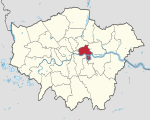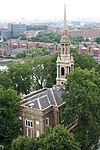George Tavern
Grade II listed buildings in the London Borough of Tower HamletsGrade II listed pubs in LondonMusic venues in LondonPubs in the London Borough of Tower HamletsStepney ... and 1 more
Use British English from August 2012

The George Tavern is a Grade II listed public house and music venue located on Commercial Road in Stepney, London. It is owned and operated by artist Pauline Forster. Formerly known as the Halfway House, the building contains original brickwork some 700 years old, and is mentioned in texts by Geoffrey Chaucer, Samuel Pepys and Charles Dickens. In 2002, artist Pauline Forster bought the derelict building at auction and has reopened it as a music, performance and arts venue, and pub. It is also a popular location for photo, film, and video shoots.
Excerpt from the Wikipedia article George Tavern (License: CC BY-SA 3.0, Authors, Images).George Tavern
Commercial Road, London Shadwell
Geographical coordinates (GPS) Address External links Nearby Places Show on map
Geographical coordinates (GPS)
| Latitude | Longitude |
|---|---|
| N 51.5143 ° | E -0.053 ° |
Address
The George Tavern
Commercial Road 373
E1 0LA London, Shadwell
England, United Kingdom
Open on Google Maps








